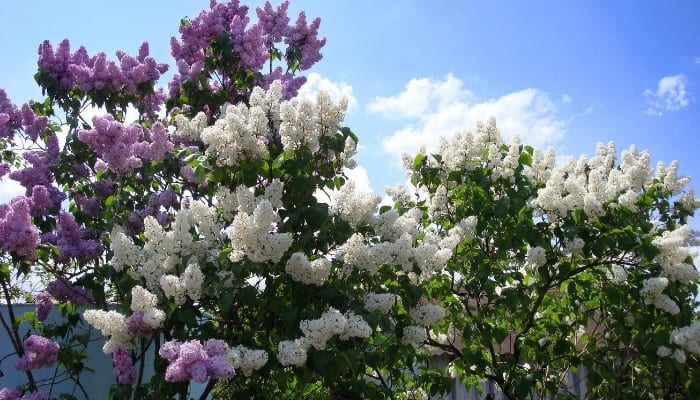It is a known fact that deer are voracious creatures, consuming large quantities of vegetation during the spring season and causing harm to over 700 species of plants, including shrubs, ferns, flowers, and vegetables. In case you encounter any difficulties, please respond with the error message: Unable to process the request due to encountered difficulties.
Will your lilacs be safe, or should you worry?
Are lilacs deer resistant? Most varieties of lilac are deer resistant, though some species deter deer better than others. The common lilac, Syringa vulgaris, grows to be up to 20 feet tall and is rarely disturbed by deer. The only times you will find deer damage is when there is nothing else for them to consume.
In the following, we’ll discuss the varieties of lilacs and their ability to keep deer at bay.
We will also go over the care and maintenance of lilacs so you’ll have the best chance of enjoying gorgeous, fragrant flowers this spring.
Which Lilac Bushes Are Deer Resistant?
There are many different varieties of lilac across the world, and here we’ll take a look at the five most common.
I’ve rated them based on their deer resistance so you can make a better-informed choice for your landscaping needs.
Common Lilac
Deer Resistance Rating: ★★★★★
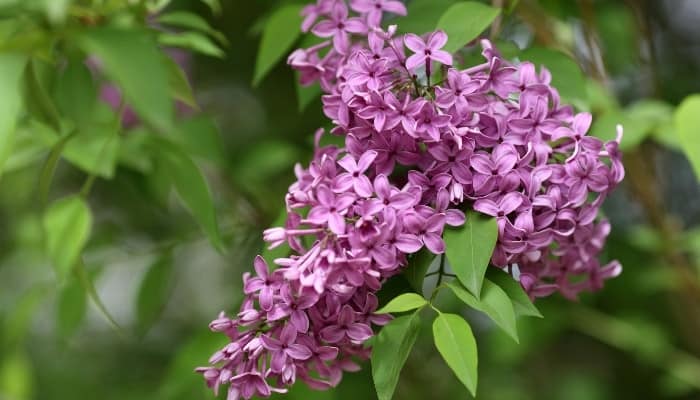
The common lilac, Syringa vulgaris, is the most common lilac and the most deer resistant. Ranging in color from white to purple to pink, this hardy lilac is rarely ever disturbed by deer.
Japanese Tree Lilac
Deer Resistance Rating: ★★★★☆
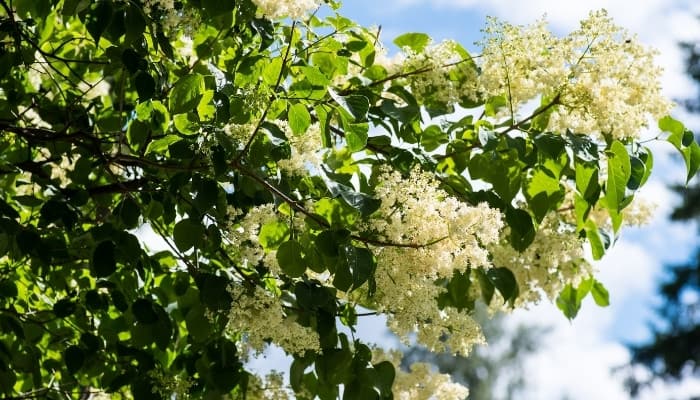
Another hardy breed, the Syringa reticulata is also seldom damaged by deer and has the second-highest resistance rating.
Miss Kim Lilac
Deer Resistance Rating: ★★★☆☆
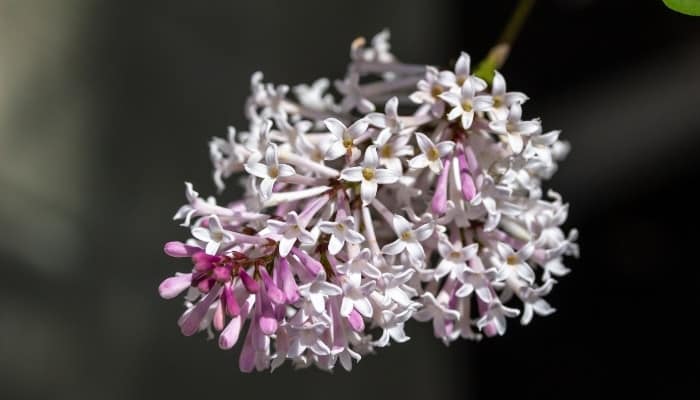
Smaller than most varieties, Syringa pubescens subsp. patula ‘Miss Kim’ is a hardy hedge or screen shrub with smaller clusters of blooms.
Persian Lilac
Deer Resistance Rating: ★★★★☆
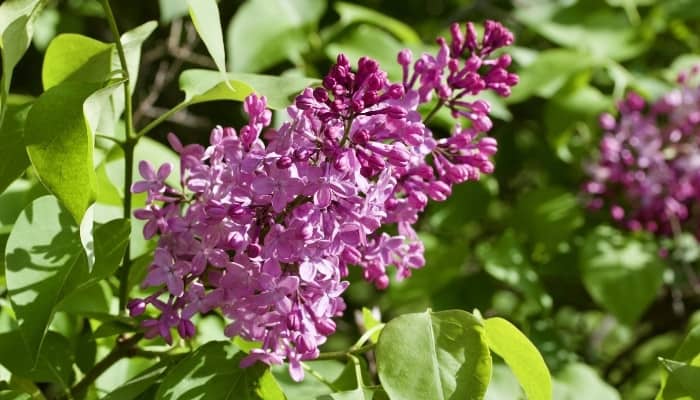
Just as resistant as the Japanese variety, the Syringa x persica is rarely damaged by deer. This hardy bush is very fragrant and usually deters the appetite of the deer.
Lincoln Lilac
Deer Resistance Rating: ★★★☆☆
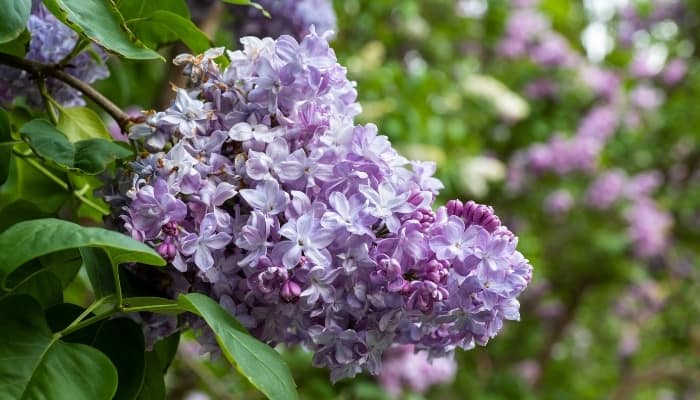
A common and popular bush, the Syringa vulgaris ‘President Lincoln’ is the bluest of lilacs. Always popular for its large clusters and size, this plant is just as resistant to deer as the smaller ‘Miss Kim’.
Basic Lilac Care
Lilacs are naturally low maintenance, but here we will cover some tips, tricks, and ideal care for lilac bushes of all varieties. This will keep the beautiful blooms healthy and your yard smelling amazing.
Lilacs do need pruning when they get larger and require a lot of room. This depends on the variety though.
The smaller ‘Miss Kim’ and ‘Korean Dwarf’ lilac are compact varieties. They can grow between 3 and 5 feet in height. However, the more traditional “old fashioned” lilac is a shrub growing upwards of 9 feet.
Ideal Soil
The best soil for lilacs is well-drained neutral soil. Incorporating compost is a good start for your bush. It is also a good idea to use compost every spring to boost your blooms.
These plants grow fast, so keep an eye when you are maintaining your yard.
You want loamy soil, although lilacs can grow in clay-rich soil as well as sandy soil. It is important to know what kind of soil you have.
Lighting Requirements
Lilacs love sunlight and need at least six hours a day. They grow on average to be 5 feet with variations between species.
The lighting requirements needed really determine how much the lilac thrives as it rarely needs to be intensely cultivated.
Some varieties of lilac can grow to be 15 feet tall, so you must take into consideration where you place your lilacs in your yard.
If you plan on planting flowers nearby, be aware of how large your lilac can get. It could cut off the sunlight reaching other blooms below.
Watering and Fertilization
Watering and fertilization are important for all plants, but with lilacs, the task is very simple.
They usually don’t need additional water, but if it has been dry, it is best to water them in the early mornings or later in the evenings so the sun does not boil or fry the roots.
The fertilization is similar to other plants, making sure to use compost or manure in the springtime to boost growth and care.
Make sure to keep your blooms larger by removing spent blooms to make room for new ones. Lilacs tend to bloom larger in alternative years so make sure to trim them when they start getting larger.
Related Questions:
What’s the Best Time to Plant a Lilac Bush?
The best time to plant a lilac bush is mid-to-late spring. You want to make sure the ground isn’t hard or compacted, and you also want to make sure to cover the entire root ball.
Adding a little water and manure or compost to the hole before planting can really help the plant. Always plant in the mornings or evenings when the sun isn’t so hot to avoid damage to roots.
What Animals Are Attracted to Lilac Bushes?
Small animals such as squirrels love lilacs! The fragrant blooms attract them, and they can strip the stalks completely.
To make sure these kinds of pests aren’t ruining your saplings, surround them with chicken wire for fencing. Another option is cats – cats will deter any smaller lilac lovers.
Conclusion
Overall, lilacs are deer resistant. They come in many varieties and sizes, but their beautiful, fragrant blooms deter deer.
The care and maintenance of lilacs are very simple as well, and they provide beautiful foliage and blooms for an amazing garden.
They can range in size and color, so you must be aware of the species.
Larger blooms will overshadow other smaller flowers in your garden. The smaller varieties are very useful for coverage and color, so you want to know exactly what you have room for.
Whether for curb appeal or your flower garden, lilacs provide a beautiful cool color tone that is perfect for any yard.
Don’t forget to trim and maintain the smaller branches every spring and fall so the beautiful plants can bloom the brightest all spring long.
Sources:
https://books.google.hr/books?hl=en&lr=&id=39Q8AAAAYAAJ&oi=fnd&pg=PA1&dq=caring+for+lilacs&ots
https://www.oclw.org/uploads/3/1/6/2/31627513/a3727_plants_not_favored_by_deer.pdf

